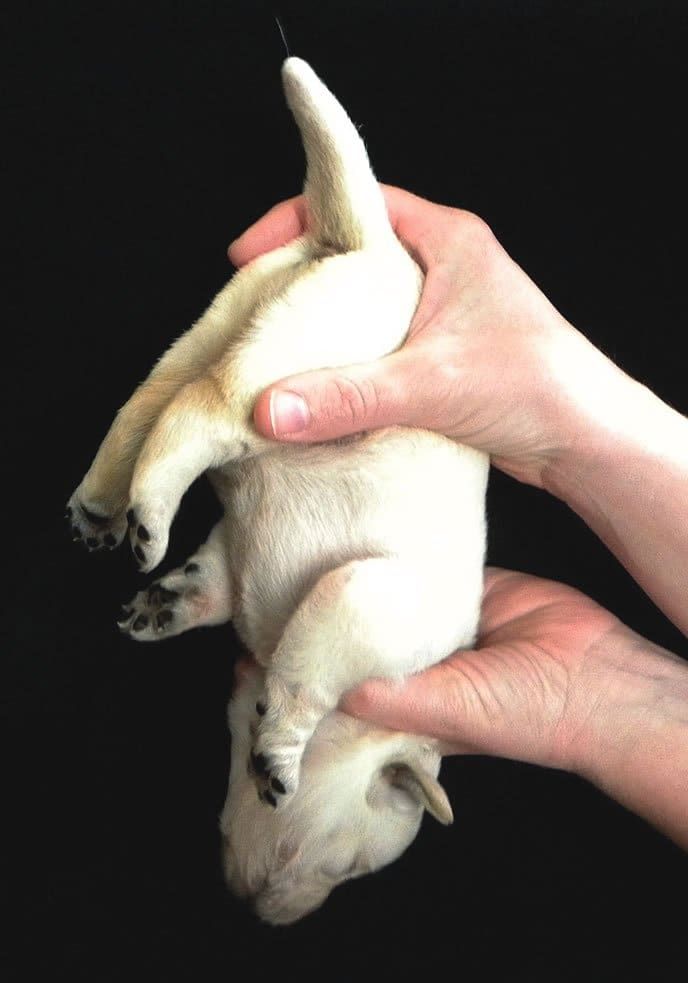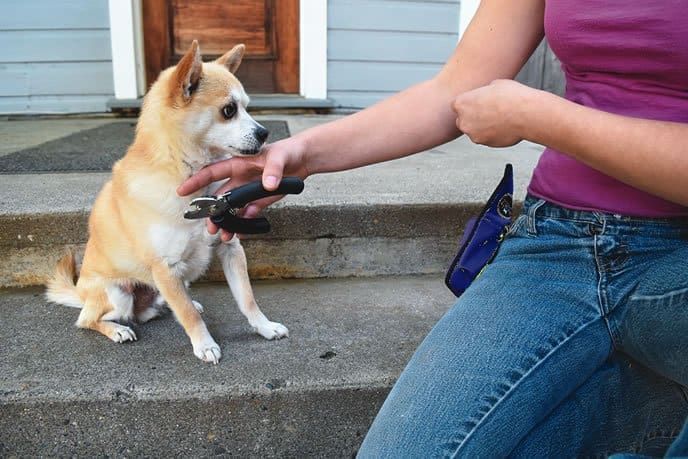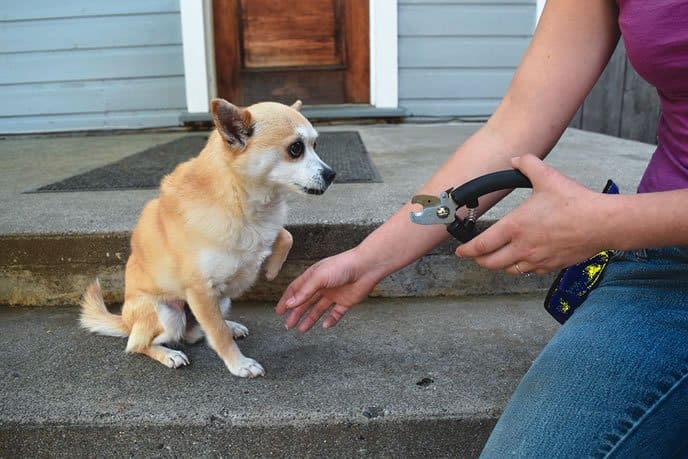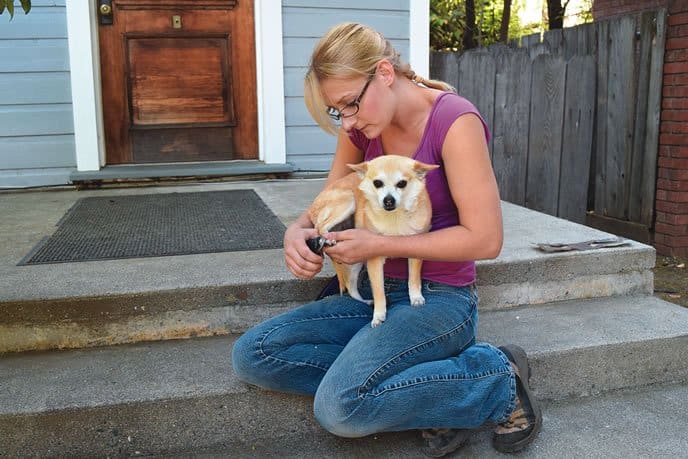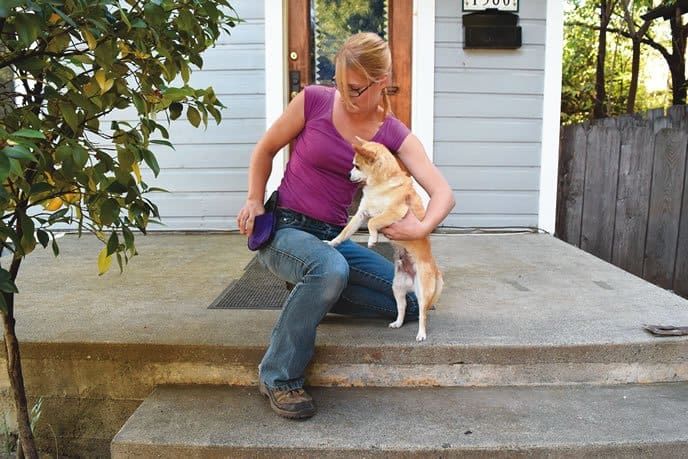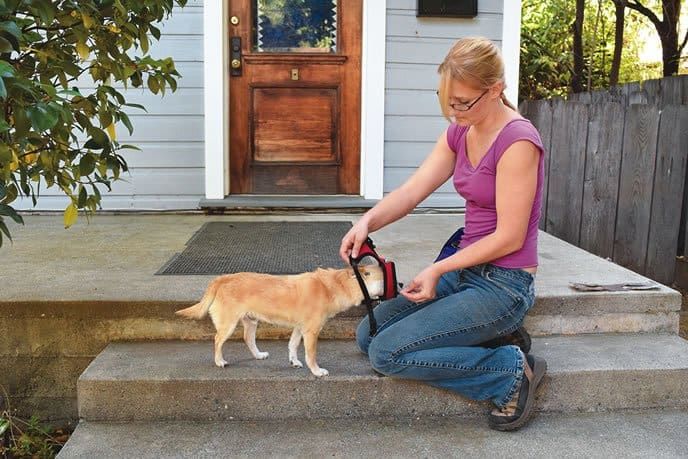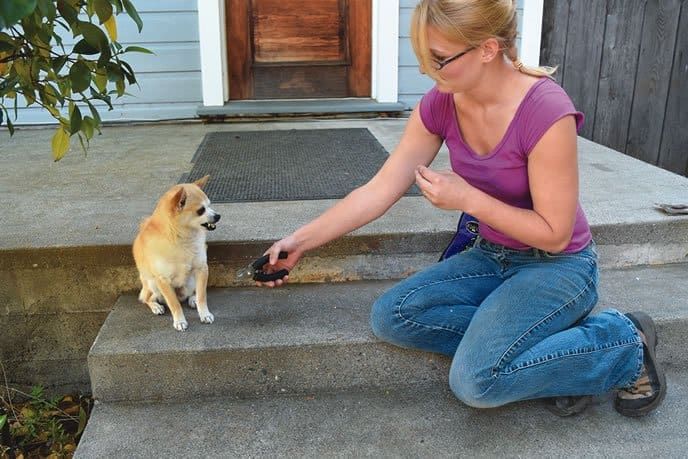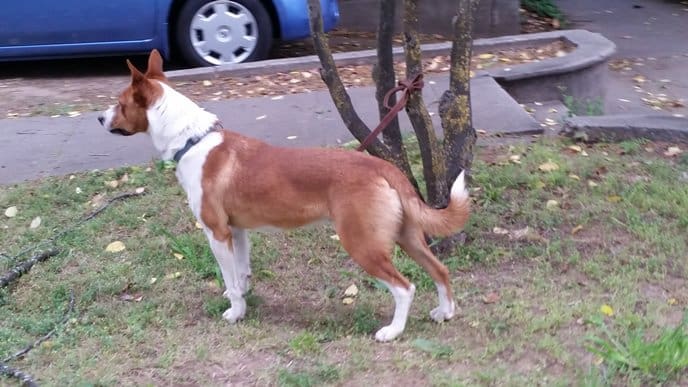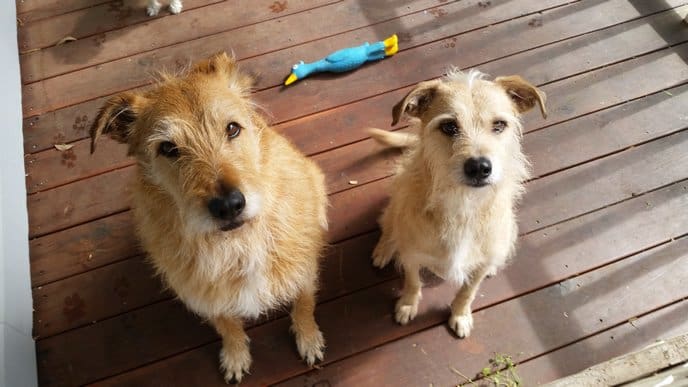Five magic words: “Wanna go for a ride?” These six simple syllables are enough to launch some dogs into a dizzying display of tail-wagging leaps and spins in eager anticipation of the fun to be found in a car buzzing along the open road. In contrast, though, are the dogs who find car rides as much fun as most humans do root canals. For some dogs, the dislike is physical; they experience motion sickness and battle with nausea, drooling, and vomiting. For others, it’s emotional, and the dog suffers from anxiety associated with riding in the car. Unfortunately, the two causes can overlap, where a dog initially experiences physical motion sickness and comes to associate the unpleasant feelings with the car, which leads to anxiety related to riding in the car.
There are a number of factors that can contribute to motion sickness in dogs.
It’s not uncommon for young puppies to experience physical motion sickness related to issues with the vestibular apparatus – the part of a mammal’s body that deals with balance and spatial orientation, explains Jennifer Jones Shults, DVM, CCRT, of Veterinary Rehabilitation and Pain Management Hospital in Cary, North Carolina. The vestibular apparatus is found in the inner ear, and consists of three fluid-filled semicircular canals. When the head moves, fluid within the canals shifts, stimulating the tiny hairs that line the canal to transmit information to the brain.

A young puppy’s body takes time to mature. For some dogs, motion sickness is the result of a vestibular system that is not yet fully developed – which is why many puppies seem to outgrow motion sickness caused by car rides as they get older.
“Young dogs with vestibular issues usually outgrow it by 5-6 months of age,” Dr. Shults says. “But bigger dogs can take longer. For example, a Great Dane isn’t considered fully mature until 2 years old, so his ear canals might take longer to reach full development than those of a Toy Poodle, who is usually fully grown somewhere between 9 to 12 months old.”
Although it takes time for the ear canals and processing centers of the brain to fully develop, not all puppies experience motion sickness. Why Puppy A handles early car rides like a champ when Puppy B is consistently car sick is not yet fully understood.
“It could be as simple as a puppy’s ear canals or semicircular canals still being too small to handle the rapid shifts in direction or the acceleration of the car, or it could have to do with what the puppy was exposed to in his first eight weeks – like rolling play with littermates or being handled upside down, which cultivates the still-developing vestibular centers in the brain. Or it could be a combination of the two,” Dr. Shults says.
Prevent Car Vomiting
Some people believe that early exposure to specific movements that challenge the vestibular apparatus can prove beneficial in protecting a puppy from experiencing motion sickness once he leaves the litter.
Heidi Mobley of Sanger, Texas, has bred Australian Shepherds for more than 25 years. She uses the Early Neurological Stimulation (ENS) or “Bio Sensor” protocol, first designed by the United States military as a way to help its working dogs grow up to reach their maximum potential. Mobley says very few of her puppies have gone on to develop motion sickness.
“I think it helps create heartier puppies by helping to get them used to different movements at a very early age,” she says.
The program consists of a series of five exercises that are done once daily between days 3 and 16. The mild stress, both as a result of being individually removed from the litter for a short time, and from the exercises themselves, stimulates the adrenal gland. It is thought that this strategic exposure to brief amounts of stress helps puppies respond better to stress later in life.
Of the five exercises, three involve specific movements that challenge the vestibular apparatus: holding the puppy so her head is up and tail is down; the reverse, where her tail is up and head is down; and holding the puppy on her back with her feet up.
“There’s a lot of research with babies that shows how early rolling movements can help the vestibular apparatus develop appropriately,” Dr. Shults says. “There aren’t any published studies showing that Early Neurological Stimulation will decrease vestibular disease in dogs, but the conduct is similar to what they recommend with children, and that has been studied in great detail. Anytime you’re upside down or on your back, the fluid in the semicircular canal has to shift, so it’s essentially like practice, and I think that makes sense.”
Nature vs. Nurture
The question of nature versus nature often comes into play when looking at animal behavior, and issues surrounding dog-related car trouble are no different. While some dogs experience motion sickness stemming from a physical issue – the vestibular apparatus – for other dogs, the problem is emotional; it’s literally all in their heads.
With that in mind, it’s extremely important that a puppy’s early exposure to the car be a positive experience. As a breeder, Mobley makes sure she’s the first person to introduce her puppies to riding in the car. She schedules the first trip for sometime between 6 and 7 weeks old, and has the puppies travel together with their mother to help keep them relaxed and comfortable. Then she specifically avoids car rides until the puppies are 10 weeks old – which means her puppies don’t typically leave for their new homes until that age.
“That’s the clincher,” she says. “The puppies I see going home between 8 and 9 weeks old are leaving during the imprint stage; if they get sick during that time, that’s when we end up with dogs who get car sick for the next two years or so. I’ve seen it happen again and again,” she adds, noting the especially strong potential for the lasting impact of negative experiences during that critical age.
Socialization Benefits for Motion Sickness
Early, effective socialization plays a key role in helping puppies and young dogs develop a positive association with riding in the car. If the only time a dog rides in the car is when he’s driven to the vet, the groomer, or the boarding kennel, there’s a good chance he’ll decide that car rides are something to be concerned about. When people get a new dog, one of the first car rides is usually to the vet for the initial wellness exam, which is often stressful.
It’s important that puppies and dogs have ample opportunities to experience the car as a portal to fun. As a trainer, I challenge my students to schedule “cookie visits” at their vet’s office, where they visit the office during a slow period simply to hang out in the waiting room, eat cookies, play with a toy if willing, schmooze with any available staff, and then go home.
Similarly, planning several short rides to fun places can help teach a dog that riding in the car is a good thing. Drive to the park for a fun walk. Drive to a friend’s house for a play date. Or even drive to your favorite fast-food restaurant where your dog gets a small bite of food from the drive-through.
Treating Motion Sickness & Car-Anxiety
To help reduce the chance that your dog will experience motion sickness, or to help minimize its effects, both Dr. Shults and Mobley recommend positioning the puppy or dog in the car so that he’s facing the direction of travel.
“The ocular center in a puppy’s brain hasn’t really developed enough for him to understand going backward; they understand going forward,” Shults says. Whether it’s riding restrained via a seatbelt or inside a carrier, facing forward helps the brain make sense of what is going on, which can lessen the chance of motion sickness. “Basically, we’re providing input though the eyes that helps the dog know which way is up,” Dr. Shults says.
Many dogs who suffer from motion sickness do better when the windows are open about three inches, to help equalize the air pressure in the car. Traveling on an empty stomach can help minimize the effects of motion sickness, and dogs who battle with motion sickness often do better if they’ve been well exercised a few hours before travel, to aid with their overall relaxation.
When riding with a dog who is getting car sick, it’s important for the owner to remain calm. A negative or hysterical response to a dog throwing up in the car can easily add to a dog’s anxiety.
There are also several natural and pharmaceutical approaches to treating motion sickness and its associated anxiety:
Homeopathic Cocculus 30c – Donna Kelleher, DVM, author of The Last Chance Dog: True Stories of Holistic Animal Healing and The Proof is in the Poodle, runs a holistic veterinary practice in Seattle, Washington, and offers a membership-based website designed to help teach people about natural treatments for a variety of chronic problems plaguing pets.
She recommends a homeopathic treatment: one pellet of Cocculus, given shortly before travel. When dosing homeopathic remedies, technique matters. The pellets should not be touched, nor should they be given by hiding them in food. Either transfer the pellets from the bottle cap directly into the dog’s mouth, or crush with the back of a metal spoon, add a bit of water, and spoon the mixture into the mouth. It’s important not to touch the pellets because that can interfere with the remedy’s vibrational force.
Homeopathic remedies such as Cocculus and flower essences (discussed below) are two of several therapies classified as “vibrational medicine.” Living organisms are multidimensional energy systems. When imbalance occurs, the energy is at a less harmonious frequency, which leads to physical and emotional symptoms. Natural-minded practitioners select certain remedies for their specific energies, with the goal of restoring balance.
– Ginger – Ginger is widely regarded as an anti-nausea remedy. Dr. Kelleher recommends making a ginger tea by steeping two tablespoons of fresh grated ginger in one cup of water, and once cooled, spooning one tablespoon per 20 pounds of the dog’s body weight into the dog the night before travel, and again an hour prior to departure.
Ginger can also be found in capsule form, and some people have reported success by sprinkling a small amount into the dog’s food. Dr. Kelleher’s preference is for fresh ginger, and if not using the tea, she would rather hide a tiny piece of fresh ginger in the dog’s food than use capsule form.
Many people who have heard about the anti-nausea properties of ginger will reach for the ginger cookie; Mobley reports success with helping many client dogs overcome motion sickness through a combination of ginger cookies and behavior modification.
If trying cookies, be sure to look for a high-quality ginger snap. The “ginger cookie” in the cookie isle of the typical mainstream grocery store is likely to be lower quality as compared to the ginger snap found in a higher-end market. For example, ginger is the seventh ingredient in a Nabisco Ginger Snap, versus the fourth ingredient in a Trader Joe’s Triple Ginger Snap. However, both versions contain sugar and flour, which many holistic practitioners, including Dr. Kelleher, recommend avoiding.
– Scullcap – Scutellaria Lateriflora is an herb that has been used for hundreds of years as a mild relaxant and as a therapy for anxiety and nervousness. Dr. Kelleher says it is safe to use with other drugs, and can be dosed at 1/2 of a capsule per 15 pounds of body weight, given one hour before travel. This won’t address nausea, but can help relieve the anxiety (panting, shaking, etc.) often experienced by dogs who have motion sickness.
– Flower Essences – Flower essences are said to be catalysts for emotional change. They are thought to trigger a balancing response in the body and are most effective when given in 3 to 6 doses throughout the day. In acute cases, a dose can be given every five minutes. Flower essences are usually found in liquid form and can be given orally, rubbed into paw pads, ear flaps, and on the belly, sprayed in the environment or on the dog’s bedding, added to water, or even added to food and treats.
The following flower-essence blends are commercially available and considered helpful as part of a desensitization and counter-conditioning protocol to address motion sickness and car-related anxiety:
– Soul Support – Contains Cattail Pollen, Chalice Well, Cotton Grass, Fireweed, Labrador Tea, Malachite, River Beauty, Ruby, and White Fireweed.
– Rescue Remedy – Contains Impatiens, Star of Bethlehem, Cherry Plum, Rock Rose, and Clematis.
– Drama Trauma – Similar to Rescue Remedy, but with double the amount of Star of Bethlehem and the addition of Star Tulip to aid in emotional grounding.
– Chiropractic Adjustment – Misalignment of vertebrae can create a variety of health and wellness issues in both people and pets, ranging from low energy and slow healing to headaches, irritability, balance issues and all levels of pain. Danielle Shelbourne of Urban Dog Training in Brisbane, Australia, has helped numerous animal clients find relief from motion sickness by working with a qualified animal chiropractor.
“We’ve found that subluxations of the atlas (C1, the topmost vertebrae, which connects to the occipital bone at the top of the head) can cause pressure around the inner ear and cause motion sickness,” says Shelbourne. “In a dog, the atlas is a large butterfly-shaped bone that can misalign easily during normal activity. Some dogs are born with vertebral subluxations, or they can develop from such activities as pulling on the leash.”
Shelbourne says that dogs with a C1 subluxation often experience not only motion sickness, but also display thunderstorm phobia, are sensitive to handling, especially around the head and heck, and can be reactive and aggressive in a variety of settings.
“In our experience, if a dog has three of these issues, we would definitely recommend chiropractic treatment, and we’d be fairly confident that the dog’s outcome would be positive,” Shelbourne says, noting that, while an adjustment might resolve the physical issue, behavior modification might still be necessary to counter a learned negative association with car travel.
William Strickland, DC, of Rose City Veterinary Hospital in Pasadena, California, has been working with animals for nearly 17 years. Cervical subluxations and soft tissue abnormalities, he says, likely contribute to motion sickness indirectly by creating imbalance. While he’s not had a client visit him with the sole complaint of motion sickness, he has seen dogs with handling sensitivities and aggression issues who also suffer from motion sickness.
Subluxations are subtle but powerful. It’s not uncommon for animals (human or canine) to experience subluxations that don’t cause symptoms that are obvious to the untrained eye, yet still create imbalance in the body. Not only does the imbalance create its own issues, but it leads to compensatory problems as the dog navigates through life in a poorly aligned state.
“One of the biggest benefits of chiropractic is as a modality for restoring balance to the entire body – the soft tissue, bones, and joints,” says Dr. Strickland. In the case of a dog with motion sickness, he says the improvement is likely the result of the animal being in overall better balance. A body out of physiologic balance can also have a harder time literally balancing while in the car, which can contribute to motion sickness.
While some people mistakenly view animal chiropractic as a heavy-handed, bone-crunching technique, Dr. Strickland notes that qualified, experienced animal chiropractors follow a “less is more” mentality, and frequently use an activator adjusting instrument, a small, hand-held tool, to painlessly deliver a gentle impulse force to the spine.
“It’s effective on babies and the elderly,” he says. “If we can safely use it on a baby or a 97-year-old grandpa, it’s certainly safe for animals of all sizes.”
Dr. Strickland notes, however, that it is important to look for a practitioner who has advanced training and experience in animal chiropractic as a specialty and to always consult with your veterinarian first to rule out a more serious cause of dysfunction or disease.
– Tactile techniques – Some dogs are also comforted by tactile techniques, such as Tellington TTouch Training, or by wearing a compression garment such as a ThunderShirt.
Medication
Conventional veterinarians have a number of prescription medications available to prescribe for dogs with serious motion sickness.
– Meclizine – The drug is sold over the counter under the brand names Antivert, Bonine, and Dramamine Less Drowsy. Dr. Shults says the generally accepted dose is one tablet for big dogs and half of a tablet for small dogs. However, it’s always wise to consult with your veterinarian before administering medications designed for human use.
– Maropitant Citrate – Sold as Cerenia®, this is the first, and currently only, FDA-approved veterinary medication designed to prevent vomiting in dogs due to motion sickness, and based on how it works, can often be more effective than meclizine.
“Meclizine works on the chemo-receptor trigger zone and on the histamine receptors in the brain,” Dr. Shults explains. “Research is showing those parts of the brain aren’t as involved in motion sickness as the substance-P receptors and the NK1 receptors, which is what Cerenia works on. That’s why the meclizine products might work on some dogs, but might not be strong enough for all dogs.”
Anxitane® (L-Theanine) – Manufactured by Virbac Animal Health, this prescription product made with L-Theanine, an amino acid found in green tea leaves, can help reduce environmental stress in both dogs and cats, and is said to help dogs with mild-moderate anxiety related to fireworks, thunderstorms, car rides, social settings and geriatric issues. Like scullcap, Anxitane doesn’t address the physical symptoms of motion sickness, but, when paired with a behavior modification plan, can help lessen the dog’s resulting anxiety.
It’s important to note that all of the approaches discussed thus far should complement, but not replace, a thoughtful behavior modification program. Helping your dog to consciously and subconsciously feel happier and more confident near and in the car will increase the odds that any other approach will be successful in improving or eliminating his motion sickness.
Desensitization and Counter-Conditioning
The goal of a solid anxiety-reduction training plan is to alter a dog’s behavior patterns by changing the way he feels about a specific situation. This is more than just getting used to riding in the car – it’s about creating a situation where the dog can associate car travel with something good.
In developing a training plan, we must first evaluate where the desired behavior has broken down. Dogs who fear riding in the car might have already learned that when the owner holds the leash and stands by the door leading to the garage, that a car ride is imminent, and, as a result, the dog resists coming to the owner in that setting.
Think of the finished behavior (calmly riding in the car) as a series of behavioral puzzle pieces that must each be tackled individually. The owner’s job, often with the help of a qualified trainer, is to help the dog become comfortable with one puzzle piece before progressing to the next. Trying to skip steps can easily backfire, as it’s not only likely that some of the previous progress will be destroyed, but the dog can be left feeling distrustful of the owner.
Remember, the goal is not just for the dog to “appear fine,” but to take the time to build a positive association with each puzzle piece. If the dog is only ever just barely “fine” with a situation under normal circumstances (for any behavior) it’s far more likely that he will actively resist the same situation under times of stress. Taking the time to build positive associations is like creating emotional padding. He might not be as relaxed and happy about the situation in times of stress (for example, in the car along a windy road or in stop-and-go traffic) as he was during training. But with some “padding,” if his behavior degrades, it’s more likely that he’ll tolerate the situation and still be fine, rather than experience an emotional meltdown. Reducing an animal’s stress makes life more pleasant for him and you. And, it’s healthier! Repeated exposure to high amounts of stress has been proven to be unhealthy for both people and pets.
Desensitizing
Think about your dog; when does he start to show signs of anxiety? Identifying the activities or locations that trigger his anxiety is critical for mapping out his behavior modification plan. Your desensitization and counter-conditioning plan should start in a place where the dog is “under threshold” – that is, has no apprehension and shows no sign of stress.
Let’s say your dog’s apprehension about being in a car starts with him balking at the sight of you holding his leash by the door. Start by picking up his leash somewhere else in the house, not anywhere near the “door of danger,” and then giving the dog some treats. When he willingly approaches (which he should do as long as you are far enough away from the place where he might otherwise feel concerned), ask him to sit, attach his leash, offer a treat or two, praise lavishly, and remove the leash.
Repeat 3 to 5 more times, then release your dog to return to his day. Repeat this simple training session randomly throughout the day, but never follow the training session with a scary car ride.
When your dog happily approaches at the sight of you holding the leash away from the “door of danger,” repeat the process a little closer to the door. The goal is to work at a level where the dog remains confident. If he looks at all concerned, you’ve progressed too quickly. Only begin the next piece of your puzzle once your dog can confidently handle the previous piece.
Throughout this process, do not try to trick the dog! The point is not to stand farther from the door in order to more easily “catch” the dog before you need to take him somewhere. In extreme cases, it’s best to avoid car rides altogether until some significant progress in these small steps been made. This can be frustrating for the owner, especially when the dog is our best hiking buddy or ribbon-winning agility partner, but it’s important to weigh the long-term benefits (years of lower-or no-stress travel) against a few weeks or months of leaving the dog at home while you work on this process.
The goal is to very gradually get closer to taking the dog for normal car rides. But the steps taken toward that goal should be very small; you’ll have the best chance of success if you refrain from moving to the next step until the dog is consistently confident at the preceding steps.
For the dog who became apprehensive when the owner picked up his leash by the door, but was confident and happy when the owner picked up the leash elsewhere in the house, the next steps might be:
– Seeing the owner with the leash or harness near the exit point of the house leading to the car.
– Seeing the car in the garage or driveway from a distance.
– Standing next to the car.
– Being asked to enter the car (or asked to enter the carrier in his car, which might be an extra puzzle piece).
– Being in the car when it’s not running.
– Being in the car when it’s idling, but not moving.
– Being in the car when it’s moving.
– Going for a very short ride up the street.
– Going for a ride around the block.
– Going for a slightly longer ride to a really fun destination.
How quickly you progress through the steps will depend on the dog.
Remember, throughout this process, it’s critical that you remain calm. Avoid getting frustrated or angry at a dog who isn’t progressing as quickly as you’d like. This holds true for a dog who is getting physically sick, too; even the owner’s panicked exclamation of “Oh no! Gross!” can compound the dog’s emotional reaction.
While it can be frustrating to deal with a dog who has “car trouble,” understanding what’s behind the issue is an important first step in seeking relief. Developing a thoughtful plan of action – coupled with time and patience – will help put your dog on the road to recovery.
Stephanie Colman is a writer and dog trainer in Los Angeles. She shares her life with a career-change search-and-rescue dog whom she is teaching to play in agility.


